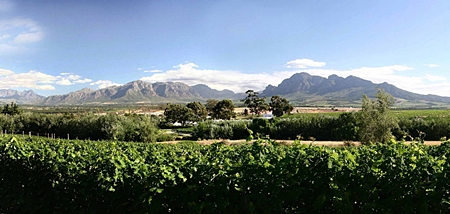Far be it from me to complain, but I get tired of hearing that old cliché about “serving red wine at room temperature”. It’s nonsense, because the temperature of a room depends on many variables, including climate. It also implies that all red wines should be served at the same temperature, which is simply not true. As I am typing this, the temperature in my study – with all the windows open – is currently 36°C (97°F) which is clearly far too hot for any wine. It’s too hot for the dogs too, who are sprawled around the floor in listless heaps.
The serving temperature of wine is crucial. Wines should be enjoyed at temperatures that show them at their best. Different wines need different serving temperatures, depending on the grape variety and place of origin. The ideal serving temperature for reds is between 12°-17°C (54°-63°F). Nothing ruins a red wine more quickly than too high a temperature.
 Breede River Valley, South Africa.
Breede River Valley, South Africa.
Here are my personal preferences for red wine, although in practice I don’t always get the temperatures exactly right. Serve full-bodied, rich reds at 16°-17°C; medium lighter-bodied reds at 13°-15°C and very light reds at 12°C. Rosé wines are usually at their best around 8°C. If in doubt, serve too cool rather than too warm.
White wines of course, need lower temperatures to bring out their natural qualities. Serve full-bodied whites at 11°C; light whites at 9°-10°C and sweet wines or sparklers at 6°-8°C. Home fridges usually run just above freezing point at 1°- 4°C, so you’ll need to remove the wine some time before you need it. If you really want to get the serving temperature right, buy a thermometer. Wine thermometers are difficult to find, but the Taylor digital cooking thermometers (from Villa Supermarket) work very well.
By the way, if you are more comfortable using Fahrenheit, you can convert the Celsius values if you multiply the figure by 1.8 and add 32. Incidentally, not being much good at arithmetic, I usually multiply by 2, take a bit away and then add 32. It’s not very scientific but usually near enough.
Chenin Blanc 2010 (white), South Africa. (Tesco-Lotus Bt. 289)
Both the wines this week are vegetarian, meaning than no animal products have been used in their manufacture. Although Chenin Blanc’s viticultural home is the Loire Valley, it’s the most planted grape variety in South Africa (where it is called “Steen”) and has been grown there since the 17th century. It often makes delightful, uncomplicated, easy-drinking wine.
This is a typical light gold with sweet, delicate and crisp floral aromas. If you sniff long enough you might pick up raisins or perhaps a hint of honey. There’s a very soft mouth-feel with low acidity and although the citrusy finish is rather short, it makes a very pleasant drink. It’s dry and light-bodied with just the tiniest hint of sweetness. At just 12% alcohol content, I’d be perfectly happy to drink this wine on its own. For a party it would be excellent, especially at this amazing low price. The label suggests that you could drink it with chicken, fish or pork but the important thing is to serve it very cold at around 9°C.
Western Cape Red Wine (red) South Africa (Tesco-Lotus, Bt. 425)
This is a pleasing ruby red colour and it has a very lively aroma of red berry fruit with a touch of herbs and background woodiness. The label doesn’t mention the grapes used, but the colour and the aroma seem to indicate that Cabernet Sauvignon is not very far away. There might even be some Pinotage there too for the taste has a kind of “edge” that this South African grape often imparts to wine. One thing is certain though, because the label gives neither precise origin nor vintage year, it is clearly a blend of wines from different years and different places.
It’s quite a pleasing, medium-bodied easy drinker; a very soft fruity mouth-feel with equally soft and supple tannins. At 12.5% alcohol content, the wine’s lively and slightly assertive quality probably calls for food such as red meats, barbeques or pasta in a rich sauce. You can drink the wine at around 13°-15°C and you’ll still get the brilliant African sunshine in every glass.




